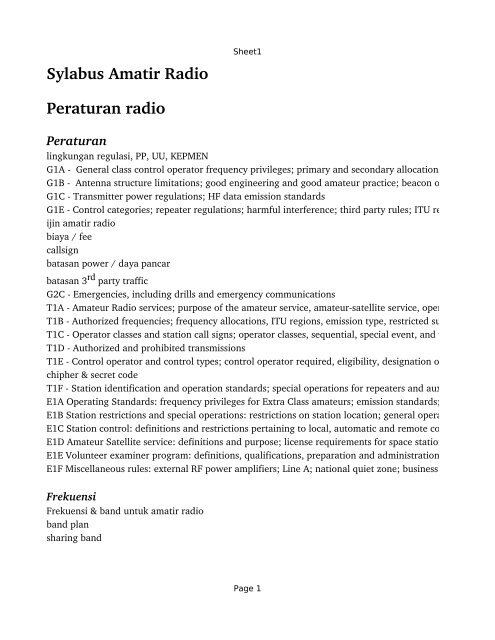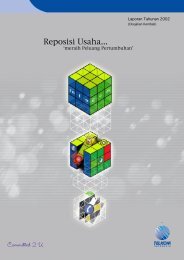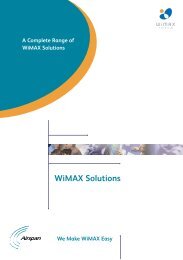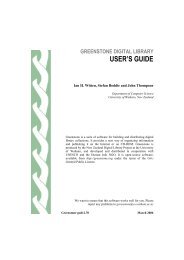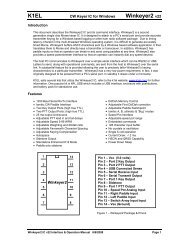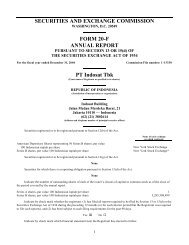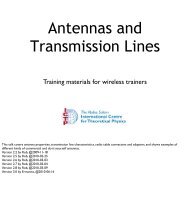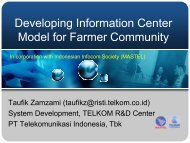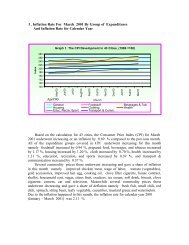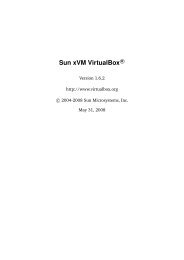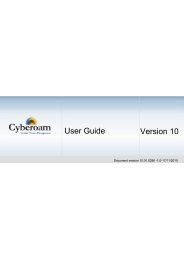silabus-amatir-radio.. - Index of
silabus-amatir-radio.. - Index of
silabus-amatir-radio.. - Index of
You also want an ePaper? Increase the reach of your titles
YUMPU automatically turns print PDFs into web optimized ePapers that Google loves.
Sylabus Amatir Radio<br />
Peraturan <strong>radio</strong><br />
Sheet1<br />
Peraturan<br />
lingkungan regulasi, PP, UU, KEPMEN<br />
G1A General class control operator frequency privileges; primary and secondary allocations<br />
G1B Antenna structure limitations; good engineering and good amateur practice; beacon operation; rest<br />
G1C Transmitter power regulations; HF data emission standards<br />
G1E Control categories; repeater regulations; harmful interference; third party rules; ITU regions<br />
ijin <strong>amatir</strong> <strong>radio</strong><br />
biaya / fee<br />
callsign<br />
batasan power / daya pancar<br />
batasan 3<br />
G2C Emergencies, including drills and emergency communications<br />
T1A Amateur Radio services; purpose <strong>of</strong> the amateur service, amateursatellite service, operator/primary<br />
T1B Authorized frequencies; frequency allocations, ITU regions, emission type, restricted subbands, spec<br />
T1C Operator classes and station call signs; operator classes, sequential, special event, and vanity call sig<br />
T1D Authorized and prohibited transmissions<br />
T1E Control operator and control types; control operator required, eligibility, designation <strong>of</strong> control oper<br />
chipher & secret code<br />
T1F Station identification and operation standards; special operations for repeaters and auxiliary stations<br />
E1A Operating Standards: frequency privileges for Extra Class amateurs; emission standards; automatic m<br />
E1B Station restrictions and special operations: restrictions on station location; general operating restrictio<br />
E1C Station control: definitions and restrictions pertaining to local, automatic and remote control operatio<br />
E1E Volunteer examiner program: definitions, qualifications, preparation and administration <strong>of</strong> exams; acc<br />
E1F Miscellaneous rules: external RF power amplifiers; Line A; national quiet zone; business communicati<br />
rd party traffic<br />
E1D Amateur Satellite service: definitions and purpose; license requirements for space stations; available f<br />
Frekuensi<br />
Frekuensi & band untuk <strong>amatir</strong> <strong>radio</strong><br />
band plan<br />
sharing band<br />
Page 1
Sheet1<br />
Teknik Operasi Stasiun Amatir Radio<br />
Prosedur Operasi<br />
Prosedur & konvensi standard untuk memanggil, menjawab dan berbicara.<br />
Memulai dan memutuskan hubungan / kontak.<br />
Teknik Pertukaran callsign.<br />
G2A Phone operating procedures; USB/LSB utilization conventions; procedural signals; breaking into a QS<br />
G2B Operating courtesy; band plans<br />
G2D Amateur auxiliary; minimizing Interference; HF operations<br />
G2E Digital operating: procedures, procedural signals and common abbreviations<br />
G2F CW operating procedures and procedural signals, Q signals and common abbreviations; full break in<br />
Pengetahuan Praktis Operasi<br />
Mengetahui terminologi yang biasa digunakan, seperti, pileup, split, contest, fox hunting.<br />
Prosedur repeater, standard split frekuensi repeater.<br />
Pengoperasian kontrol standard di transmitter / receiver.<br />
T2A Station operation; choosing an operating frequency, calling another station, test transmissions, use o<br />
T2B – VHF/UHF operating practices; SSB phone, FM repeater, simplex, frequency <strong>of</strong>fsets, splits and shifts,<br />
T2C –Public service; emergency and nonemergency operations, message traffic handling<br />
E2A Amateur <strong>radio</strong> in space: amateur satellites; orbital mechanics; frequencies and modes; satellite hardw<br />
E2B Television practices: fast scan television standards and techniques; slow scan television standards and<br />
E2C Operating methods, part 1: contest and DX operating; spreadspectrum transmissions; automatic HF f<br />
E2D Operating methods, part 2: VHF and UHF digital modes; packet clusters; Automatic Position Reportin<br />
E2E Operating methods, part 3: operating HF digital modes; error correction<br />
Kode Q<br />
Kode Q yang banyak digunakan di komunikasi <strong>amatir</strong> <strong>radio</strong>.<br />
Teknik Radio<br />
Dasar Teori Elektronika<br />
Dasar Elektronika<br />
Atom dan partikel subatomik, elektron, ion.<br />
Page 2
Sheet1<br />
Insulator, konduktur dan semikonduktor.<br />
Medan yang dihasilkan oleh arus dan magnet.<br />
Tipe batere.<br />
T5A Electrical principles; current and voltage, conductors and insulators, alternating and direct current<br />
E5A Resonance and Q: characteristics <strong>of</strong> resonant circuits: series and parallel resonance; Q; halfpower ba<br />
E5B Time constants and phase relationships: R/L/C time constants: definition; time constants in RL and R<br />
E5C Impedance plots and coordinate systems: plotting impedances in polar coordinates; rectangular coord<br />
E5D AC and RF energy in real circuits: skin effect; electrostatic and electromagnetic fields; reactive power<br />
Unit Ukuran<br />
Unit dari tegangan, arus, tahanan, impendasi, daya.<br />
Hukum Ohm<br />
Perhitungan melibatkan tegangan, arus, tahanan (menggunakan satu tahanan).<br />
T5D – Ohm’s Law<br />
Tahanan / Resistansi<br />
G6A Resistors; capacitors; inductors<br />
Nilai dari tahanan di seri atau paralel (menggunakan dua atau lebih tahanan).<br />
Perhitungan melibatkan tahanan kombinasi, tegangan, arus.<br />
Tahanan dalam dari batere.<br />
G5C – Resistors, capacitors, and inductors in series and parallel; transformers<br />
Perhitungan Daya / Power<br />
Perhitungan daya jika di ketahui dua (2) dari tegangan, arus atau tahanan.<br />
Daya di tahanan jika di sambungkan secara seri atau paralel.<br />
Arus Bolak Balik<br />
Frekuensi, bentuk gelombang dan unit.<br />
Bentuk gelombang, RMS, nilai peak (puncak).<br />
T5C Electronic principles; capacitance, inductance, current flow in circuits, alternating current, definition<br />
Kapasitor, Induktif dan Resistor<br />
G5A Resistance; reactance; inductance; capacitance; impedance; impedance matching<br />
Varisasi dari kapasitansi dengan besarnya plat, spasi.<br />
Dielektrik.<br />
Page 3
Sheet1<br />
Variasi dari induktansi dengan diameter, panjang, banyaknya lilitan.<br />
C dan L di seri dan paralel.<br />
Variasi Reaktansi dari C, L, dengan frekuensi.<br />
Impedansi.<br />
Induktor Toroid.<br />
Trafo, perbandingan lilitan, transformasi tegangan.<br />
Resonansi L dan C di seri dan paralel.<br />
Nilai Q.<br />
Keamanan / Safety<br />
Prosedur dasar untuk mengangkat seseorang dari tegangan listrik yang hidup.<br />
Cara kerja sekering, isolating transformer, RCD (Residual Current Device).<br />
Grounding.<br />
G0B Safety in the ham shack: electrical shock and treatment, grounding, fusing, interlocks, wiring, anten<br />
G0A RF safety principles, rules and guidelines; routine station evaluation<br />
Guna dari kabel ground, bagaimana cara menyambungkannya.<br />
T0A – AC power circuits; hazardous voltages, fuses and circuit breakers, grounding, lightning protection, b<br />
T0B – Antenna installation; tower safety, overhead power lines<br />
T0C RF hazards; radiation exposure, proximity to antennas, recognized safe power levels, exposure to ot<br />
E0A Safety: amateur <strong>radio</strong> safety practices; RF radiation hazards; hazardous materials<br />
Semikonduktor<br />
Sifat dasar dari material semikonduktor.<br />
Sifat dasar dan penggunaan dioda, dioda zener, transistor.<br />
T6B – Semiconductors; basic principles <strong>of</strong> diodes and transistors<br />
Pengenalan Divais<br />
G6B Rectifiers; solid state diodes and transistors; solar cells; vacuum tubes; batteries<br />
G6C Analog and digital integrated circuits (IC’s); microprocessors; memory; I/O devices; microwave IC’s<br />
G7A Power supplies; transmitters and receivers; filters; schematic symbols<br />
Pengenalan nama elektroda dari transistor bipolar, FET, tabung, dari diagram.<br />
T6A Electrical components; fixed and variable resistors, capacitors, and inductors; fuses, switches, batter<br />
T6D Component functions<br />
E6A Semiconductor materials and devices: semiconductor materials (germanium, silicon, Ptype, Ntype);<br />
E6B Semiconductor diodes<br />
E6C Integrated circuits: TTL digital integrated circuits; CMOS digital integrated circuits; gates<br />
E6D Optical devices and toroids: vidicon and cathoderay tube devices; chargecoupled devices (CCDs); liq<br />
Page 4
Sheet1<br />
E6E Piezoelectric crystals and MMICS: quartz crystals (as used in oscillators and filters); monolithic amplif<br />
E6F Optical components and power systems: photoconductive principles and effects, photovoltaic systems<br />
Alat Ukur dan Pengukuran<br />
Fungsi dasar dari voltmeter, ammeter, SWR, bridge, power meter.<br />
Impedansi dari peralatan ini di rangkaian.<br />
Bagaimana cara peralatan di sambungkan.<br />
Nilai peak dan RMS.<br />
T7D – Basic repair and testing; soldering, use <strong>of</strong> a voltmeter, ammeter, and ohmmeter<br />
E4A Test equipment: analog and digital instruments; spectrum and network analyzers, antenna analyzers;<br />
E4B Measurement technique and limitations: instrument accuracy and performance limitations; probes; te<br />
E4C Receiver performance characteristics, part 1: phase noise, capture effect, noise floor, image rejection,<br />
E4D Receiver performance characteristics, part 2: blocking dynamic range, intermodulation and crossmod<br />
E4E Noise suppression: system noise; electrical appliance noise; line noise; locating noise sources; DSP no<br />
Decibel, Amplifikasi dan Attenuasi<br />
Perbandingan daya, tegangan dan arus dalam dB.<br />
Gain / penguatan dalam dB untuk sistem yang saling tersambung.<br />
G5B The Decibel; current and voltage dividers; electrical power calculations; sine wave rootmeansquare<br />
T5B Math for electronics; decibels, electronic units and the metric system<br />
Stasiun Amatir Radio<br />
Rangkaian Elektronika<br />
G7B Digital circuits (gates, flipflops, shift registers); amplifiers and oscillators<br />
T6C Circuit diagrams; schematic symbols<br />
E7 Digital circuits: digital circuit principles and logic circuits: classes <strong>of</strong> logic elements; positive and negati<br />
E7B Amplifiers: Class <strong>of</strong> operation; vacuum tube and solidstate circuits; distortion and intermodulation; s<br />
E7C Filters and matching networks: filters and impedance matching networks: types <strong>of</strong> networks; types <strong>of</strong><br />
E7D Power supplies and voltage regulators<br />
E7E Modulation and demodulation: reactance, phase and balanced modulators; detectors; mixer stages; D<br />
E7F Frequency markers and counters: frequency divider circuits; frequency marker generators; frequency c<br />
E7G Active filters and opamps: active audio filters; characteristics; basic circuit design; operational amplif<br />
E7H Oscillators and signal sources: types <strong>of</strong> oscillators;<br />
synthesizers and phaselocked loops; direct digital synthesizers<br />
Page 5
Sheet1<br />
Sinyal dan Emisi<br />
G8A Carriers and modulation: AM; FM; single and double sideband ; modulation envelope; deviation; ov<br />
G8B Frequency mixing; multiplication; HF data communications; bandwidths <strong>of</strong> various modes<br />
T8A – Modulation modes; bandwidth <strong>of</strong> various signals<br />
T8B Amateur satellite operation; Doppler shift, basic orbits, operating protocols<br />
T8C – Operating activities; <strong>radio</strong> direction finding, <strong>radio</strong> control, contests, special event stations, basic link<br />
T8D – Nonvoice communications; image data, digital modes, CW, packet, PSK31<br />
E8A AC waveforms: sine, square, sawtooth and irregular waveforms; AC measurements; average and PEP<br />
E8B Modulation and demodulation: modulation methods; modulation index and deviation ratio; pulse mo<br />
E8C Digital signals: digital communications modes; CW; information rate vs. bandwidth; spreadspectrum<br />
E8D Waves, measurements, and RF grounding: peaktopeak values, polarization; RF grounding<br />
Arrangement Stasiun HF<br />
Mengerti blok diagam dari stasiun HF biasa.<br />
Bagaimana menyambungkan transceiver ke linear amplifier.<br />
Low pass filter.<br />
SWR, Antenna Switch, Antenna Tuner, Dummy Load dan antenna.<br />
Fungsi dasar dari masingmasing blok.<br />
G4A Twotone Test; amplifier tuning and neutralization; DSP<br />
G4B Test and monitoring equipment<br />
G4C Interference with consumer electronics; grounding<br />
G4D Speech processors; S meters; common connectors<br />
G4E HF mobile <strong>radio</strong> installations; emergency and battery powered operation<br />
T4A – Station setup; microphone, speaker, headphones, filters, power source, connecting a computer, RF g<br />
T4B Operating controls; tuning, use <strong>of</strong> filters, squelch, AGC, repeater <strong>of</strong>fset, memory channels<br />
T7A Station <strong>radio</strong>s; receivers, transmitters, transceivers<br />
T7B – Common transmitter and receiver problems; symptoms <strong>of</strong> overload and overdrive, distortion, interfe<br />
Radio Penerima<br />
Blok Diagram Penerima<br />
Blok Diagram penerima SSB, CW, dan FM.<br />
Mengerti fungsi dari masingmasing blok.<br />
Page 6
Sheet1<br />
Cara Kerja Penerima<br />
Sensitifitas, Selektifitas, Receiver Noise.<br />
Teknik operasi dari superheterodyne, RF amplifier, IF amplifier, mixer, translator frekuensi, sinyal bayang<br />
Radio Pemancar<br />
Blok Diagram Pemancar<br />
Blok diagram pemancar SSB, CW, dan FM.<br />
Mengerti fungsi masingmasing blok.<br />
Karakteristik sinyal yang di hasilkan.<br />
Amplifier Linier dan Nonlinier.<br />
Teori Pemancar<br />
Arti dari “SSB”, “CW”, “FM”.<br />
Karakteristik dari sinyal SSB, CW dan FM.<br />
Penyebab distrorsi.<br />
Distribusi daya di pemancar.<br />
Harmonik dan Parasitik<br />
Frekuensi harmonik.<br />
Penyebab harmonik dan parasitik di pemancar.<br />
Teknik filter untuk mengurangi harmonik dan parasitik.<br />
Catu Daya<br />
Catu Daya<br />
Batere.<br />
Catu daya DC.<br />
Guna dari dioda, kapasitor, trafo.<br />
Penyearah gelombang penuh dan setengah gelombang.<br />
Ripple.<br />
Frekuensi.<br />
Regulated Power Supply.<br />
Page 7
Sheet1<br />
Pengaturan dari trafo, penyearah, filter, regulator.<br />
Mengetahui fungsi dasar dari masingmasing blok.<br />
Guna sekering.<br />
Cara operasi switched mode power supply, kelebihan dan kekurangannya.<br />
Dari Pemancar Ke Penerima<br />
Saluran Transmisi<br />
pembuatan saluran transmisi coaxial<br />
pembuatan saluran transmisi twinlead<br />
saluran balanced dan unbalanced<br />
loss di saluran<br />
standing wave, SWR<br />
Antenna<br />
panjang dipole, vertikal di berbagai frekuensi<br />
G9B Basic antennas<br />
G9C Directional antennas<br />
G9D Specialized antennas<br />
impedansi, posisi feedpoint<br />
matching<br />
antenna bandwidth<br />
elemen dari antenna yagi, arah radiasi<br />
medan E dan H sekitar antenna<br />
polarisasi<br />
tuning antenna menggunakan induktasi<br />
balun<br />
G9A Antenna feedlines: characteristic impedance, and attenuation; SWR calculation, measurement and e<br />
dummy antenna<br />
isotropic antenna<br />
T7C – Antenna measurements and troubleshooting; measuring SWR, dummy loads, feedline failure modes<br />
T9A – Antennas; vertical and horizontal, concept <strong>of</strong> gain, common portable and mobile antennas, relation<br />
T9B Feedlines; types, losses vs. frequency, SWR concepts, matching, weather protection, connectors<br />
E9A Isotropic and gain antennas: definition; used as a standard for comparison; radiation pattern; basic an<br />
E9B Antenna patterns: E and H plane patterns; gain as a function <strong>of</strong> pattern; antenna design (computer m<br />
E9C Wire and phased vertical antennas: beverage antennas; terminated and resonant rhombic antennas; e<br />
E9D Directional antennas: gain; satellite antennas; antenna beamwidth; losses; SWR bandwidth; antenna<br />
Page 8
Sheet1<br />
E9E Matching: matching antennas to feed lines; power dividers<br />
E9F Transmission lines: characteristics <strong>of</strong> open and shorted feed lines: 1/8 wavelength; 1/4 wavelength; 1<br />
E9G The Smith chart<br />
Propagasi<br />
E3A Propagation and technique, part 1: EarthMoonEarth communications; meteor scatter<br />
E3B Propagation and technique, part 2: transequatorial; long path; gray line; multipath propagation<br />
E3C Propagation and technique, part 3: Auroral propagation; selective fading; <strong>radio</strong>path horizon; take<strong>of</strong>f<br />
fenomena dasar propagasi di HF, VHF dan UHF<br />
lapisan yang merefleksikan sinyal<br />
serapan di lapisan D<br />
daerah skip, hop, MUF, LUF, OWF<br />
solar cycle<br />
skywave, ground wave<br />
sporadic E<br />
great circle path, sudut radiasi, fading<br />
doppler karena pergerakan satelit<br />
G3A Sunspots and solar radiation; ionospheric disturbances; propagation forecasting and indices<br />
G3B Maximum Usable Frequency; Lowest Usable Frequency; propagation "hops"<br />
G3C Ionospheric layers; critical angle and frequency; HF scatter; Near Vertical Incidence Sky waves<br />
T3A Radio wave characteristics; how a <strong>radio</strong> signal travels; distinctions <strong>of</strong> HF, VHF and UHF; fading, mu<br />
T3B Radio and electromagnetic wave properties; the electromagnetic spectrum, wavelength vs. frequency<br />
T3C Propagation modes; line <strong>of</strong> sight, sporadic E, meteor, aurora scatter, tropospheric ducting, F layer sk<br />
Interferensi<br />
Penyebab dan teknik mengatasi keyclick<br />
Penyebab dan teknik mengatasi cross modulasi<br />
harmonik yang tidak di inginkan<br />
definisi lowpass, bandpass, bandreject, notch, dan highpass filter<br />
Teknik Komunikasi Digital<br />
Dasar komunikasi digital<br />
Nama dari mode digital yang sering digunakan<br />
Prinsip dari system BBS<br />
Modem, TNC<br />
Page 9
YB YC YD/YH<br />
x x x<br />
x<br />
x<br />
x<br />
x<br />
x x x<br />
x x x<br />
x x x<br />
x x x<br />
x x x<br />
x<br />
x<br />
x<br />
x<br />
x<br />
x<br />
x x<br />
x<br />
x<br />
x<br />
x<br />
x<br />
x<br />
x<br />
x x x<br />
x x x<br />
x x<br />
Sheet1<br />
Page 10
x x x<br />
x x x<br />
x x x<br />
x<br />
x<br />
x<br />
x<br />
x<br />
x x<br />
x x x<br />
x x<br />
x<br />
x<br />
x<br />
x<br />
x<br />
x<br />
x<br />
x<br />
x x x<br />
x<br />
Sheet1<br />
Page 11
x x x<br />
x x x<br />
x x x<br />
x<br />
x<br />
x<br />
x<br />
x<br />
x x x<br />
x x x<br />
x<br />
x<br />
x x x<br />
x x<br />
x x<br />
x<br />
x x x<br />
x x<br />
x x x<br />
x x<br />
x<br />
x<br />
x x<br />
x x<br />
Sheet1<br />
Page 12
x<br />
x x x<br />
x<br />
x x<br />
x x x<br />
x x x<br />
x<br />
x<br />
x x x<br />
x x x<br />
x x x<br />
x<br />
x<br />
x x x<br />
x<br />
x<br />
x<br />
x<br />
x<br />
x x<br />
x<br />
x<br />
x<br />
x<br />
x x x<br />
x<br />
x<br />
x<br />
x<br />
x<br />
x<br />
Sheet1<br />
Page 13
x<br />
x<br />
x x x<br />
x x<br />
x x x<br />
x x<br />
x<br />
x<br />
x<br />
x<br />
x<br />
x<br />
x x<br />
x x<br />
x<br />
x<br />
x<br />
x<br />
x<br />
x<br />
x<br />
x<br />
x<br />
x<br />
x<br />
x<br />
x<br />
Sheet1<br />
Page 14
x<br />
x<br />
x<br />
x<br />
x<br />
x<br />
x<br />
x<br />
x<br />
x<br />
x x x<br />
x x<br />
x x<br />
x x x<br />
x x x<br />
x<br />
x<br />
x<br />
x<br />
x<br />
x<br />
x<br />
x<br />
x<br />
x x x<br />
x x x<br />
Sheet1<br />
Page 15
x<br />
x x<br />
x x x<br />
x x x<br />
x x<br />
x x<br />
x x x<br />
x x<br />
x x<br />
x x<br />
x x x<br />
x<br />
x x<br />
x x x<br />
x x x<br />
x x x<br />
x x x<br />
x x<br />
x x<br />
Sheet1<br />
Page 16
x x<br />
x x<br />
x x<br />
x<br />
x x<br />
x<br />
x x<br />
x x<br />
x x<br />
x x x<br />
x<br />
x<br />
x<br />
x x x<br />
x x<br />
x x<br />
x x<br />
x x<br />
x x<br />
x<br />
x x<br />
x<br />
x x<br />
x<br />
x<br />
x<br />
x<br />
x<br />
x<br />
x<br />
x<br />
Sheet1<br />
Page 17
x<br />
x<br />
x<br />
x<br />
x<br />
x<br />
x x x<br />
x x<br />
x x<br />
x x<br />
x<br />
x x<br />
x<br />
x<br />
x x<br />
x<br />
x<br />
x<br />
x<br />
x<br />
x<br />
x x<br />
x x<br />
x x<br />
x x<br />
x x<br />
x x x<br />
x<br />
x x<br />
Sheet1<br />
Page 18


